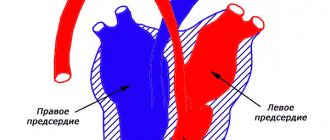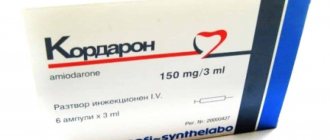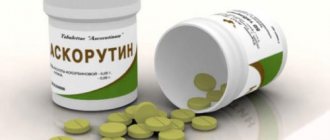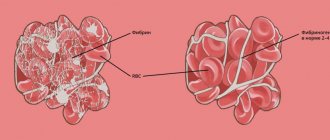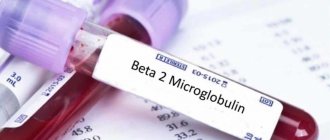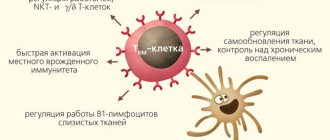Pharmacodynamics and pharmacokinetics
Let's consider the mechanism of action of the drug.
A herbal drug, digoxin is obtained from the woolly foxglove (Digitalis). It has a pronounced cardiotonic effect (positive inotropic effect, increasing the contractility of the heart muscle by increasing the concentration of calcium ions in cardiomyocytes), thereby increasing stroke volume and minute volume. Reduces the need of myocardial cells for oxygen.
In addition, it has a negative dromotropic and negative chronotropic effect, that is, it reduces the frequency of generation of an electrical impulse by the sinus node and the speed of impulse conduction through the atrioventricular conduction system of the heart. It also has an indirect effect on the receptors of the aortic arch and increases the activity of the vagus nerve, which also slows down the activity of the sinoatrial node.
Thanks to these mechanisms, it is possible to achieve a reduction in heart rate during supraventricular (supraventricular) tachyarrhythmias (paroxysmal or permanent forms of atrial tachyarrhythmias, atrial flutter).
In case of severe insufficiency of cardiac function and signs of stagnation in the systemic and pulmonary circulation, the drug has an indirect vasodilatory effect, which is manifested in a decrease in the overall resistance of the peripheral vascular bed and a decrease in the severity of shortness of breath and peripheral edema.
It is taken orally, 70% of the active substance is absorbed into the gastrointestinal tract, after administration the maximum concentration is reached in the interval from two to 6 hours. Parallel food intake leads to a slight increase in absorption time. The exception is products rich in plant fiber - in this case, part of the active substance is adsorbed by dietary fiber and becomes inaccessible.
It tends to accumulate in fluids and tissues, including the myocardium, which is used when determining the regimen of use: the effect of the drug is calculated not by the maximum concentration of the substance in the plasma, but by the content at the time of the equilibrium state of pharmacokinetics.
50-70% of drugs are excreted by the kidneys; severe pathology of this organ can contribute to the accumulation of digoxin in the body. The half-life reaches two days.
Detailed description of the study
Digoxin is a drug that is widely prescribed in cardiology for the treatment of congestive heart failure and abnormal heart rhythm (atrial fibrillation). This is due to its ability to increase the force of contraction of the heart muscle (myocardium), which improves heart function.
Long-term treatment with digoxin helps to reduce the size of the heart and has a positive effect on the distribution of blood flow. The drug helps slow and stabilize the rate of ventricular contraction. This effect on the heart is carried out due to direct and indirect effects on the myocardium, blood vessels and the autonomic nervous system.
Digoxin is well absorbed after oral administration and accumulates in many organs, especially the heart, kidneys and liver. A number of factors can influence the normal absorption, distribution in the body and bioavailability of the drug:
- Presence of food in the intestines;
- Composition and metabolism of intestinal microflora;
- Intensity of physical activity;
- Taking diuretics, quinidine and a number of other drugs;
- Age (children usually require higher concentrations of digoxin).
After oral administration, an increase in digoxin levels in the blood is first observed, then it accumulates in the tissues. Leveling of serum and tissue levels of the drug occurs after approximately 6-8 hours. Digoxin is excreted primarily in the urine. The average half-life is 36 to 40 hours.
The drug has a narrow therapeutic window, meaning there is a very small gap between the safe and toxic tissue concentrations of the drug. Digoxin toxicity is caused by a combination of several factors:
- Individuals vary in their ability to metabolize digoxin;
- The absorption of different tablet forms of the drug may differ by 2 times;
- The likelihood of digoxin toxicity increases with age and when taking diuretics that increase potassium levels in the blood.
Elimination of the drug may be slower in people with impaired renal function.
Symptoms of digoxin poisoning often cause heart rhythm disturbances. Other typical manifestations of an overdose with this drug include gastrointestinal symptoms: nausea, vomiting, abdominal pain and diarrhea, lack of appetite, as well as weakness, malaise, dizziness, decreased visual acuity. In severe cases, visual and auditory hallucinations are observed.
Studying the concentration of digoxin in the blood allows you to successfully monitor the therapy of cardiovascular diseases with this drug.
Indications for use of Digoxin
What are tablets and solution usually used for?
Indications for the use of Digoxin are heart rhythm disturbances ( arrhythmias ) of a supraventricular nature ( paroxysmal atrial fibrillation , atrial flutter , constant atrial fibrillation ).
The medication is included in treatment regimens for chronic heart failure of the third and fourth functional classes, and is also used for class 2 CHF if pronounced clinical manifestations are diagnosed.
Contraindications
Direct contraindications for prescribing the drug are signs of glycoside intoxication, hypersensitivity to digoxin, Wolff-Parkinson-White syndrome , atrioventricular block and complete atrioventricular block, bradycardia .
The medication should not be prescribed for such manifestations of coronary heart disease as unstable angina and acute myocardial infarction .
The drug is contraindicated in isolated mitral stenosis .
Heart failure of the diastolic type (with cardiac tamponade , with constrictive pericarditis , with cardiac amyloidosis , with cardiomyopathy ) is also a contraindication to the use of Digoxin.
Severe dilatation of the heart, obesity , renal and hepatic parenchyma failure, myocardial inflammation, hypertrophy of the interventricular septum, subaortic stenosis , ventricular tachyarrhythmias - in these conditions the use of the drug is unacceptable.
Side effects
First of all, you need to pay attention to possible side effects from the cardiovascular system, as they may be the first signs of developing glycoside intoxication .
Such symptoms include a slowdown in atrioventricular conduction and, as a consequence, a slowdown in rhythm ( bradycardia ), the appearance of heterotropic foci of myocardial excitation, manifested in the development of ventricular arrhythmias ( extrasystoles ) and ventricular fibrillation .
Extracardiac side effects, unlike intracardiac ones, do not pose a threat to the patient’s life. These include signs of dysfunction of the digestive tract (nausea, pain in the stomach, vomiting and diarrhea ), nervous system ( headaches , depression or psychosis , disruption of the visual analyzer in the form of flies before the eyes, etc.).
On the blood side, there may be a disturbance in the morphological picture in the form of thrombocytopenia , and it will manifest itself as petechiae on the skin.
It is also possible to develop allergic reactions to Digoxin in the form of skin erythema , itching and rash.
Instructions for use of Digoxin (Method and dosage)
The inclusion of medication in treatment regimens should be carried out exclusively in a hospital setting. The therapeutic window of Digoxin (the interval between the therapeutic dose and the toxic dose) is extremely short, and therefore all recommendations for taking the medication must be strictly followed.
Digoxin tablets, instructions for use
At the first stage of treatment (the stage of digitalization, or saturation of the patient’s body with the drug), the drug is prescribed in a dosage that is usually called saturating: the patient takes from two to four tablets (which is 500 mcg - 1 mg), after which they switch to taking one tablet at a time with an interval of 6 hours. This continues until a therapeutic effect is obtained, and a stable concentration of digoxin in the blood is achieved within seven days.
At the next stage, they switch to regularly taking a maintenance dose of the drug, which is usually half a tablet or one tablet per day (one tablet of Digoxin contains 250 mcg of active substance). You should not skip taking a medication, nor should you take a double dose at one time if you miss a dose. This is fraught with the development of intoxication, which can be fatal.
In cardiology departments and in the cardiac intensive care unit, the medication is also prescribed intravenously to relieve supraventricular paroxysmal tachyarrhythmias .
Digoxin 0.25 mg No. 50 tablet.
Instructions for the use of the drug for specialists DIGOXIN Trade name Digoxin International nonproprietary name Digoxin (Digoxinum) Dosage form Tablets 0.25 mg Composition One tablet contains the active substance - digoxin 0.25 mg, excipients: fillers: sucrose - 20.40 mg, potato starch – 15.30 mg, binders: sucrose – 4.20 mg, glucose monohydrate – 8.50 mg, glidants: talc – 0.9 mg, calcium stearate – 0.25 mg, surfactant: vaseline oil – 0.20 mg. Description White, flat-cylindrical tablets Pharmacotherapeutic group Cardiac glycosides. Digitalis glycosides. ATC code C01AA05 Pharmacological properties Pharmacokinetics When taken orally, digoxin is usually absorbed within the range of 60-85% (mainly from the small intestine). Food slows down the rate of absorption of the drug. The effect occurs within 2 hours and reaches a maximum after 6 hours. The therapeutic concentration in plasma is individual and is 0.5-2 ng/ml. Digoxin binds to blood proteins within 20-30%, the free fraction penetrates into tissues, primarily into the heart muscle. The concentration of digoxin in the heart muscle is greater than in the plasma. Since most of the drug is in the tissues, digoxin is poorly dialyzed during hemodialysis (3% over 5 hours). Digoxin is excreted in breast milk. The elimination half-life is 1.5-2 days. Digoxin is excreted through the kidneys (by glomerular filtration and tubular secretion), mainly unchanged. Excretion depends on the rate of glomerular filtration. Pharmacodynamics Digoxin is a cardiac glycoside obtained from Digitalis lanata. The mechanism of action is based on inhibition of the Na-K pump of the cell membrane. As a result, the extracellular concentration of potassium ions and the intracellular concentration of sodium ions increases. With the participation of intracellular sodium ions, the content of calcium ions in the cell increases, as a result of which the ATPase activity of myosin increases. The drug has positive inotropic and negative chronotropic effects. Indications for use - chronic heart failure - supraventricular tachyarrhythmias (especially atrial fibrillation) Method of administration and dosage To open the blister pack, lightly press the tablet and remove it from the foil. When taken orally, the saturation dose for rapid digitalization is 0.5-1 mg, after which 0.25 mg is given every 6 hours until the desired therapeutic effect is achieved. The highest daily dose is 1.5 mg. If the patient does not need such rapid digitalization, you can take 0.25 mg 1-2 times a day. Steady-state plasma concentrations are usually achieved within 7 days. The usual maintenance dose is 0.125-0.25 mg per day. An elderly patient should use small doses of the drug, starting treatment with slow digitalization. In case of renal failure, the dose should be reduced in accordance with the glomerular filtration rate (GFR) (GFR 20-50 ml/min - 0.25 mg per day; GFR 10-20 ml/min - 0.125-0.25 mg per day; GFR < 10 ml/min - up to 0.125 mg per day). Elderly patients. Due to reduced renal function and low body weight in elderly patients, the doses used should be lower than in middle-aged people. In elderly patients, serum digoxin levels should be monitored and hypokalemia should be avoided. Side effects - signs of digoxin poisoning are various disturbances of heart rhythm and conduction - ventricular extrasystoles such as bigeminy or trigeminy - arterial tachycardia with atrioventricular block is also quite often observed, in which the pulse rate may be low - prolongation of the PR interval and depression of the ST segment on the ECG, that in the absence of other symptoms does not indicate digoxin poisoning - lack of appetite, nausea, vomiting and diarrhea - weakness, apathy, fatigue, headache, visual impairment, depression and even psychosis - after long-term treatment with digoxin, gynecomastia was observed - itching, urticaria and thrombocytopenia - rarely intestinal ischemia, intestinal necrosis. Contraindications - ventricular tachycardia - ventricular fibrillation - hypertrophic obstructive cardiomyopathy (except in cases of severe heart failure) - Wolff-Parkinson-White syndrome (especially with concomitant atrial fibrillation) - periodic complete atrioventricular block or second degree atrioventricular block - hypersensitivity to digoxin or others cardiac glycosides - for cardiac arrhythmias caused by digital intoxication - childhood. Drug interactions The use of thiazides and loop diuretics can cause a decrease in potassium and magnesium levels and contribute to the occurrence of cardiac arrhythmia. Hypokalemia can also occur with the use of glucocorticosteroids and amphotericin. Hypercalcemia may increase digoxin toxicity, so intravenous calcium should be avoided during use of cardiac glycosides. The use of quinidine, amiodarone and propafenone during digoxin treatment increases the plasma concentration of digoxin. The simultaneous use of antiarrhythmic drugs increases the incidence of side effects. The simultaneous use of beta-blockers and digoxin may increase bradycardia. Verapamil increases plasma digoxin concentrations; nifedipine may or may not increase plasma digoxin concentrations. Erythromycin, tetracycline, trimethoprim, angiotensin-converting enzyme inhibitors (captopril), angiotensin II receptor blockers (eg, telmisartan), proton pump blockers (eg, omeprazole), and non-steroidal anti-inflammatory substances may increase plasma digoxin levels. Due to the acceleration of biotransformation due to the induction of liver enzymes, rifampicin reduces the content of digoxin in the blood plasma. Cholestyramine, cholestipol, sulfasalazine, sucralfate, neomycin, laxatives containing magnesium, and antacids reduce the absorption of digoxin. The effect of digoxin is also weakened by metoclopramide. When digoxin is used simultaneously with verapamil and beta blockers, the possibility of atrioventricular block increases. Special instructions Digoxin should be used with caution in patients with acute myocardial damage (myocarditis, recent infarction), with worsening heart failure or severe pulmonary disease. Large single doses should be avoided. Caution must also be exercised with atrioventricular block of varying severity and with sick sinus syndrome if the patient experiences attacks of atrial fibrillation. If the patient has used cardiac glycosides within the previous two weeks, it is recommended to reduce the initial dose of digoxin. It is recommended to stop treatment with digoxin 24-48 hours before elective cardioversion, as there is a risk of life-threatening arrhythmias. In case of impaired renal function, as well as when using digoxin in elderly patients or premature infants, the dose should be reduced and the plasma concentration of digoxin should be monitored. The effect of digoxin may be enhanced by hypokalemia, hypomagnesemia, hypercalcemia, hypoxia and hypothyroidism. In these cases, the dose of digoxin should be reduced. In hyperthyroidism, relative resistance to digoxin may occur. When using therapeutic doses of digoxin, the ECG may show prolongation of the PR interval and depression of the ST segment. Under the influence of digoxin during physical activity, the ECG may show false-positive changes in the ST-T segment, which are not signs of poisoning, but only passing natural changes caused by the mechanism of action of the drug. Pregnancy and lactation Digoxin penetrates the placental barrier. When using digoxin in therapeutic doses in the fetus and newborn, no special side effects were identified. Digoxin use during pregnancy may cause a baby to have a low birth weight. An overdose of digoxin during pregnancy can lead to fetal death. During pregnancy, digoxin clearance increases. Peculiarities of the drug's influence on the ability to drive a vehicle or potentially dangerous machinery. The drug does not affect the ability to drive vehicles or operate technical devices. Overdose The breadth of the therapeutic effect of the drug is small. Taking 10-15 mg of digoxin can cause death due to overdose in 50% of adults. Symptoms of poisoning develop gradually and are described in the part regarding side effects. The greatest danger is heart rhythm disturbances, which can cause death due to ventricular fibrillation or asystole caused by blockade. If the drug is taken in a very large dose accidentally or for the purpose of suicide, then gastric lavage can be done immediately after the overdose. Activated carbon, by binding digoxin, prevents its absorption from the digestive tract. Dialysis is not effective for life-threatening digoxin poisoning. Bradyarrhythmia associated with poisoning can be treated using atropine or connecting a temporary pacemaker. Ventricular arrhythmias are treated with lidocaine or phenytoin. For bradyarrhythmia and ventricular arrhythmia, digoxin-specific antibodies - F(ab) fragments (Wellcome) can be used. Release form and packaging Tablets, 0.25 mg, 25 pcs. in blister packs, 2 blister packs per pack. Storage conditions Store in a place protected from light at a temperature not exceeding 25° C. Keep out of the reach of children! Shelf life: 5 years After the expiration date indicated on the package, do not use! Conditions for dispensing from pharmacies By prescription Manufacturer JSC Grindeks (Grindeks), st. Krustpils 53, Riga, LV-1057 Latvia.
Overdose
Symptoms of overdose (glycoside intoxication): heart rate slows down, sinus bradycardia . The electrocardiogram shows signs of slowing atrioventricular conduction, up to complete atrioventricular block. Heterotropic rhythm sources produce ventricular extrasystoles, and ventricular fibrillation is possible. Extracardiac symptoms of glycoside intoxication are manifested by dyspepsia (nausea, diarrhea, anorexia), decreased memory and cognitive function, drowsiness, headaches, muscle weakness, erectile dysfunction , gynecomastia , psychosis , anxiety, euphoria , xanthopsia , decreased visual acuity and other disorders in the work of the visual analyzer.
If signs of intoxication with glycosides appear, tactics depend on the severity of the manifestations: it is enough to reduce the dose of Digoxin for minor manifestations of overdose. If there is progression of side effects, it is worth taking a short break, the duration of which depends on the dynamics of signs of intoxication. Acute Digoxin poisoning requires gastric lavage and taking sorbents in large quantities. The patient is given a laxative.
Ventricular arrhythmias can be eliminated by intravenous administration of potassium chloride with the addition of insulin. Potassium preparations should absolutely not be prescribed when atrioventricular conduction is slowed. If the arrhythmia persists, phenytoin .
Atropine is used to treat bradycardia . In parallel, oxygen therapy and drugs that increase circulating blood volume are prescribed. The antidote for Digoxin is Unithiol .
It is important to remember that an overdose can be fatal.
Digoxin enhances the action of the vagus nerve on the AV node, slowing the conduction of electrical impulses and thereby reducing the frequency of ventricular responses to impulses from the atria. This effect can be used to reduce heart rate in patients with atrial fibrillation. Digitalis preparations have been used by cardiologists since the 18th century, and their position has changed several times. The last time digoxin's position was shaken was in 2014, when the results of the TREAT-AF study were published (https://pubmed.ncbi.nlm.nih.gov/). Giving digoxin to patients with new-onset atrial fibrillation has been shown to increase mortality by 21%. This has led to significant restrictions on the use of this drug.
However, the use of digoxin in patients with true permanent AF, in whom restoration or maintenance of sinus rhythm is not possible, and the course of the disease or concomitant pathology has led to the development of heart failure, has not been evaluated in randomized trials. Beta blockers are the first-line treatment for these patients. This position is based on the results of studies in which patients with CHF and sinus rhythm had undeniable benefits from the administration of beta blockers, while in patients with CHF and sinus rhythm, the administration of digoxin had a neutral effect on the prognosis.
A specially conducted meta-analysis showed that the use of beta blockers in patients with CHF and AF is not associated with a reduction in mortality (https://pubmed.ncbi.nlm.nih.gov/25193873/). In addition, the adverse outcomes often associated with digoxin use in observational studies may be due to digoxin being prescribed to the sickest patients who are intolerant of beta blockers or in whom beta blockers are ineffective. The journal JAMA published the results of a small, open-label, randomized trial comparing the use of digoxin (62.5-250 mcg) and Concor (1.25-15 mg) as first-line rhythm-sparing therapy in patients with AF and CHF with reduced LVEF. A total of 160 patients were included in the study (average age 76 years, average heart rate at inclusion was 100 beats/min). The average dose of digoxin was 161 mcg, Concor - 3.2 mg. The duration of observation is 12 months.
The incidence of the primary endpoint, quality of life at 6 months, assessed by the SF-36 PCS questionnaire, did not differ significantly between groups. However, at 12 months, the digoxin group showed benefit in 8 of the 17 secondary endpoints analyzed. Among other things, after a year of taking digoxin, the level of NT-proBNP (960 pg/ml vs 1250 pg/ml; P = 0.005) and the severity of symptoms of CHF according to the New York classification were significantly lower (1.5 vs 2, respectively; P <0.001 ). In the digoxin group, a decrease in FC by 2 points or more was observed 4 times more often. Moreover, treatment side effects were significantly less common in the digoxiin group. HR after a year of treatment did not differ significantly between the groups and was 76.9 in the digoxin group and 74.8 in the Concor group.
Thus, the authors conclude that the use of digoxin as rhythm-slowing therapy in patients with persistent AF and CHF with reduced LVEF is a valid option.
Based on materials:
Kotecha D, Bunting KV, Gill SK, et al. Effect of Digoxin vs Bisoprolol for Heart Rate Control in Atrial Fibrillation on Patient-Reported Quality of Life: The RATE-AF Randomized Clinical Trial. JAMA. 2020;324(24):2497–2508. doi:10.1001/jama.2020.23138
Text: Shakhmatova O.O.
https://jamanetwork.com/
Interaction
The medicine cannot be combined with alkalis, acids, salts of heavy metals and tannins. When used together with diuretics, insulin, calcium salts, sympathomimetics, and glucocorticosteroids, the risk of symptoms of glycoside intoxication increases.
In combination with Quinidine , Amiodarone and Erythromycin, an increase in digoxin levels in the blood is observed. Quinidine inhibits the excretion of the active substance.
The calcium channel blocker Verapamil reduces the rate of elimination of digoxin from the body by the kidneys, which leads to an increase in the concentration of cardiac glycoside. This effect of Verapamil is gradually leveled off with prolonged co-administration of the drugs (more than six weeks).
Combination with Amphotericin B increases the likelihood of developing an overdose of glycosides due to hypokalemia , which is provoked by Amphotericin B. Hypercalcemia increases the susceptibility of cardiomyocytes to cardiac glycosides, and therefore one should not resort to intravenous administration of calcium preparations to patients taking cardiac glycosides. Simultaneous use of Digoxin in combination with Reserpine , Propranolol , phenytoin increases the likelihood of developing ventricular arrhythmias.
Phenylbutazone reduce the concentration and effectiveness of the drug . Potassium supplements, drugs that reduce the acidity of gastric juice, and Metoclopramide . When combined with the antibiotics erythromycin and Gentamicin, the content of the glycoside in the patient’s plasma increases. Simultaneous use of the drug with cholestipol , cholestyramine and magnesium laxatives leads to a deterioration in the absorption of the drug in the intestine, as a result of which there is a decrease in the amount of digoxin in the body. The metabolism of glycosides is accelerated when taken in combination with Rifampicin and sulfosalazine .
Digoxin
When digoxin is co-administered with drugs that cause electrolyte imbalance, in particular hypokalemia (for example, diuretics, glucocorticosteroids, insulin, beta-agonists, amphotericin B), the risk of arrhythmias and the development of other toxic effects of digoxin increases. Therefore, intravenous administration of calcium salts should be avoided in patients taking digoxin. In these cases, the dose of digoxin must be reduced.
Some drugs may increase serum digoxin concentrations, such as quinidine, calcium channel blockers (especially verapamil), amiodarone, spironolactone, and triamterene.
Absorption of digoxin in the intestine can be reduced by the action of cholestyramine, colestipol, aluminum-containing antacids, neomycin, and tetracyclines.
There is evidence that the concomitant use of spironolactone not only changes the concentration of digoxin in the blood serum, but also may affect the results of the method for determining the concentration of digoxin, therefore special care is required when assessing the results obtained.
When used simultaneously with digoxin, the following drugs may interact, as a result of which the therapeutic effect is reduced or the side or toxic effect of digoxin appears: mineralocorticosteroids, glucocorticosteroids. having significant mineralocorticosteroid effects; amphotericin B for injection; carbonic anhydrase inhibitors; adrenocorticotropic hormone (ACTH); diuretics that promote the release of water and potassium (bumetanide, ethacrynic acid, furosemide, indapamide, mannitol and thiazide derivatives); sodium phosphate.
Hypokalemia caused by these drugs increases the risk of toxic effects of digoxin, therefore, when used simultaneously with digoxin, constant monitoring of potassium concentration in the blood is required.
— Preparations of St. John's wort (their interaction with digoxin induces P-glycoprotein and cytochrome P450, i.e. it reduces bioavailability, increases metabolism and significantly reduces the concentration of digoxin in plasma);
— Amiodarone
(increases the concentration of digoxin in the blood plasma to a toxic level). The interaction of amiodarone and digoxin inhibits the activity of the sinus and atrioventricular nodes of the heart, and the conduction of electrical impulses through the conduction system of the heart. Therefore, after prescribing amiodarone, digoxin is canceled or its dose is reduced by half;
— Preparations of aluminum and magnesium salts and other antacids
may reduce the absorption of digoxin and reduce its concentration in the blood;
— Simultaneous use with digoxin: antiarrhythmic drugs, calcium salts, pancuronium, rauwolfia alkaloids, succinylcholine and sympathomimetics
may provoke the development of heart rhythm disturbances, therefore in these cases it is necessary to monitor the patient’s cardiac activity and ECG;
— Kaolin, pectin and other adsorbents, cholestyramine, colestipol, laxatives, neomycin and sulfasalazine
reduce the absorption of digoxin and thereby reduce its therapeutic effect;
— Blockers of “slow” calcium channels, captopril
- increase the concentration of digoxin in the blood plasma, therefore, when using them together, it is necessary to reduce the dose of digoxin. so that the toxic effects of the drug do not manifest themselves;
— Edrophonium chloride
(anticholinesterase agent) - increases the tone of the parasympathetic nervous system, so its interaction with digoxin can cause severe bradycardia;
— Erythromycin
— its action improves the absorption of digoxin in the intestine;
— Heparin
— digoxin reduces the anticoagulant effect of heparin, so its dose has to be increased;
— Indomethacin
reduces the release of digoxin, so the risk of toxic effects of the drug increases;
— magnesium sulfate solution for injection
used to reduce the toxic effects of cardiac glycosides;
— Phenylbutazone
- reduces the concentration of digoxin in the blood serum;
— potassium salt preparations
, they should not be taken if conduction disturbances on the ECG appear under the influence of digoxin. However, potassium salts are often prescribed along with digitalis preparations to prevent cardiac arrhythmias;
— Quinidine and quinine
- these drugs can sharply increase the concentration of digoxin;
— Spironolactone
- reduces the rate of release of digoxin, so it is necessary to adjust the dosage of the drug when used together;
— Thallium chloride
(TL 201) - when studying myocardial perfusion with thallium preparations, digoxin reduces the degree of thallium accumulation in areas of damage to the heart muscle and distorts the study data;
— Thyroid hormones
- when prescribed, metabolism increases, so the dose of digoxin should definitely be increased.
Digoxin price, where to buy
Buy Digoxin tablets 50 pcs. possible for a price of about 60 rubles.
- Online pharmacies in RussiaRussia
- Online pharmacies in UkraineUkraine
- Online pharmacies in KazakhstanKazakhstan
ZdravCity
- Digoxin tab.
0.25 mg 30 pcs Usolye-Sibirsky Chemical Pharmaceutical Plant JSC 42 RUR order - Digoxin tablets 0.25 mg 30 pcs. Pharmstandard-Tomskkhimpharm/Pharmstandard-Leksredstva OJSC
39 RUR order
- Digoxin tab. 0.25 mg 50 pcs JSC Gedeon Richter / Gedeon Richter-RUS JSC
60 rub. order
- Digoxin tablets 0.25 mg 56pcs AO PFC update
67 RUR order
Pharmacy Dialogue
- Digoxin (tablet 0.25 mg No. 50)Gedeon-Richter
56 RUR order
- Digoxin (tab. 250 µg No. 30) FS.-Leksredstva
42 RUR order
- Digoxin (tablet 0.25 mg No. 30) FS.-Tomskkhimpharm
42 RUR order
- Digoxin (tab. 0.25 mg No. 56)Update of PFC JSC
62 RUR order
show more
Pharmacy24
- Digoxin 0.25 mg No. 40 tablets PAT NEC "Borshchagivsky chemical and pharmaceutical plant", Kiev, Ukraine
7 UAH. order
PaniPharmacy
- DIGOXIN tablets Digoxin tablets. 0.1 mg No. 50 Ukraine, OZ GNTsLS LLC
9 UAH order
- DIGOXIN ampoule Digoxin solution d/in. 0.025% amp. 1ml No. 10 Ukraine, OZ GNTsLS LLC
39 UAH order
- DIGOXIN tablets Digoxin tablets 0.25 mg No. 40 Ukraine, Borshchagovsky Chemical Plant PJSC
9 UAH order
- DIGOXIN tablets Digoxin tablets 0.25 mg No. 50 Ukraine, Health LLC
11 UAH order
show more


